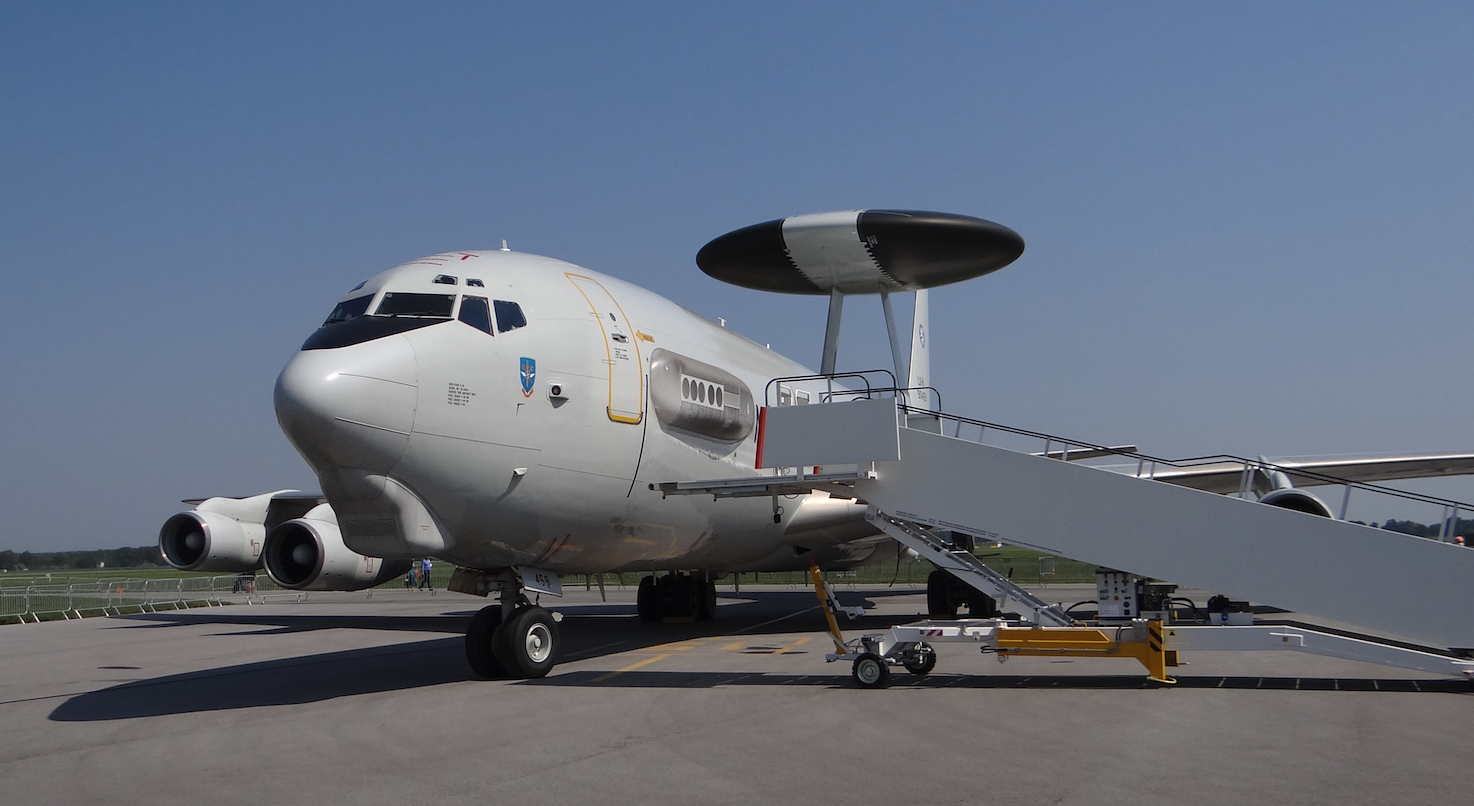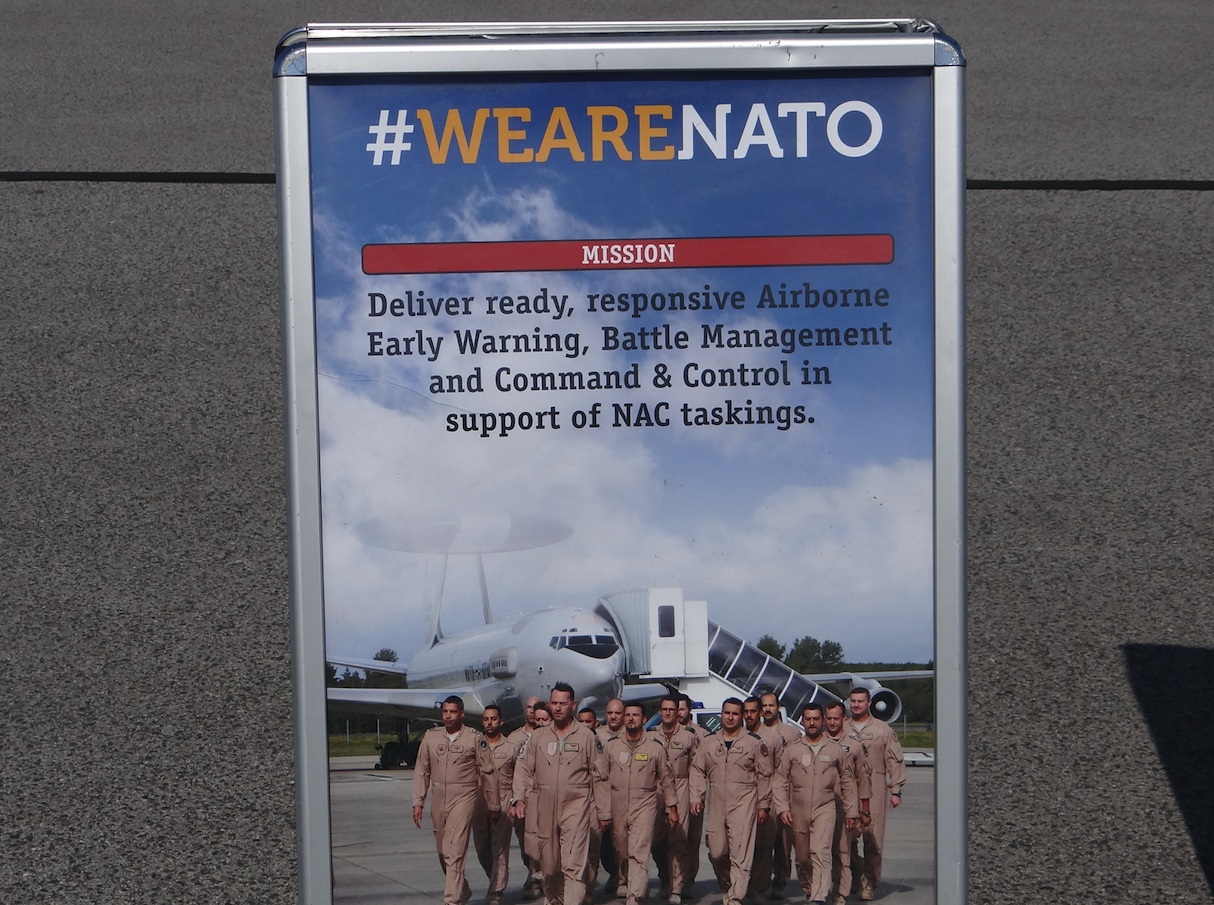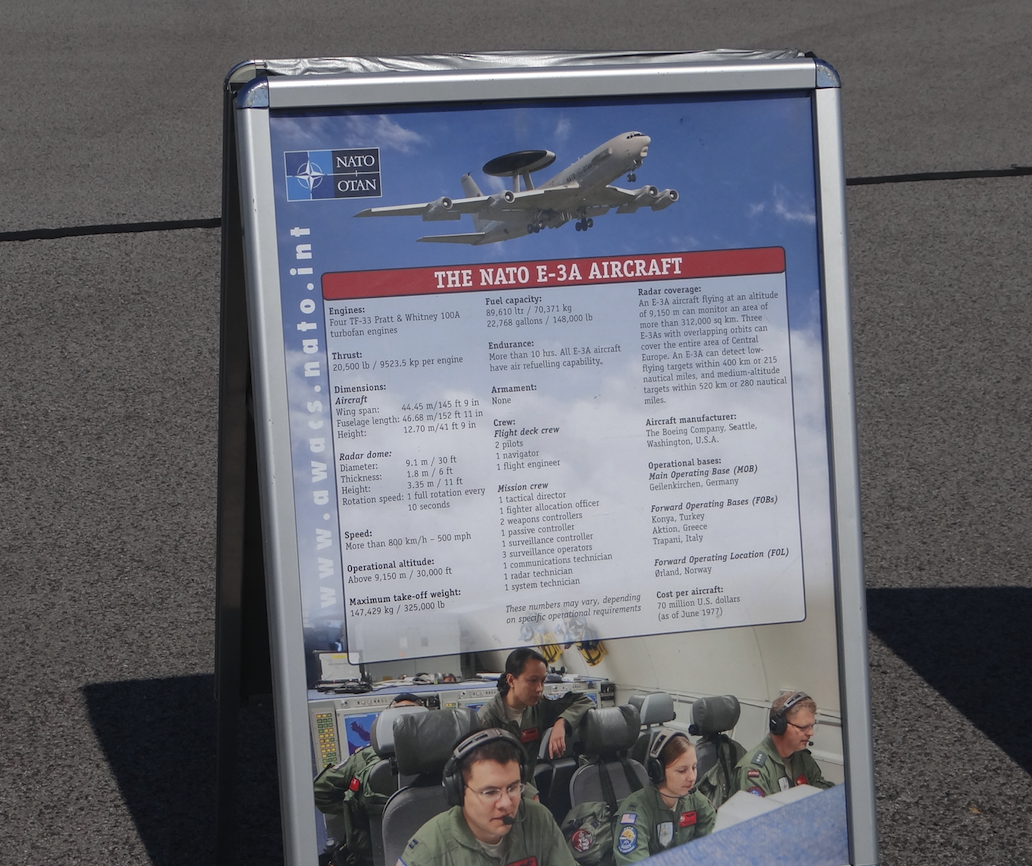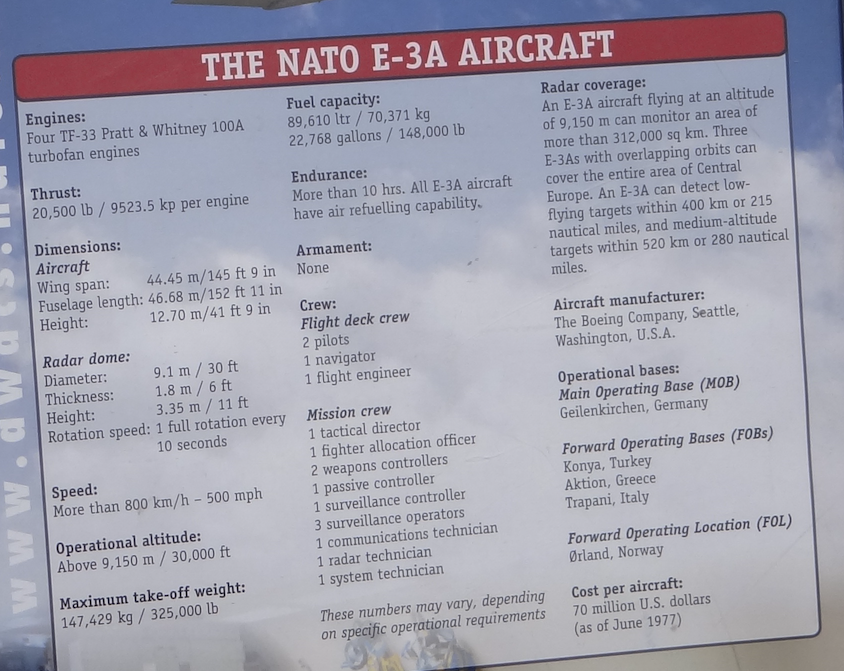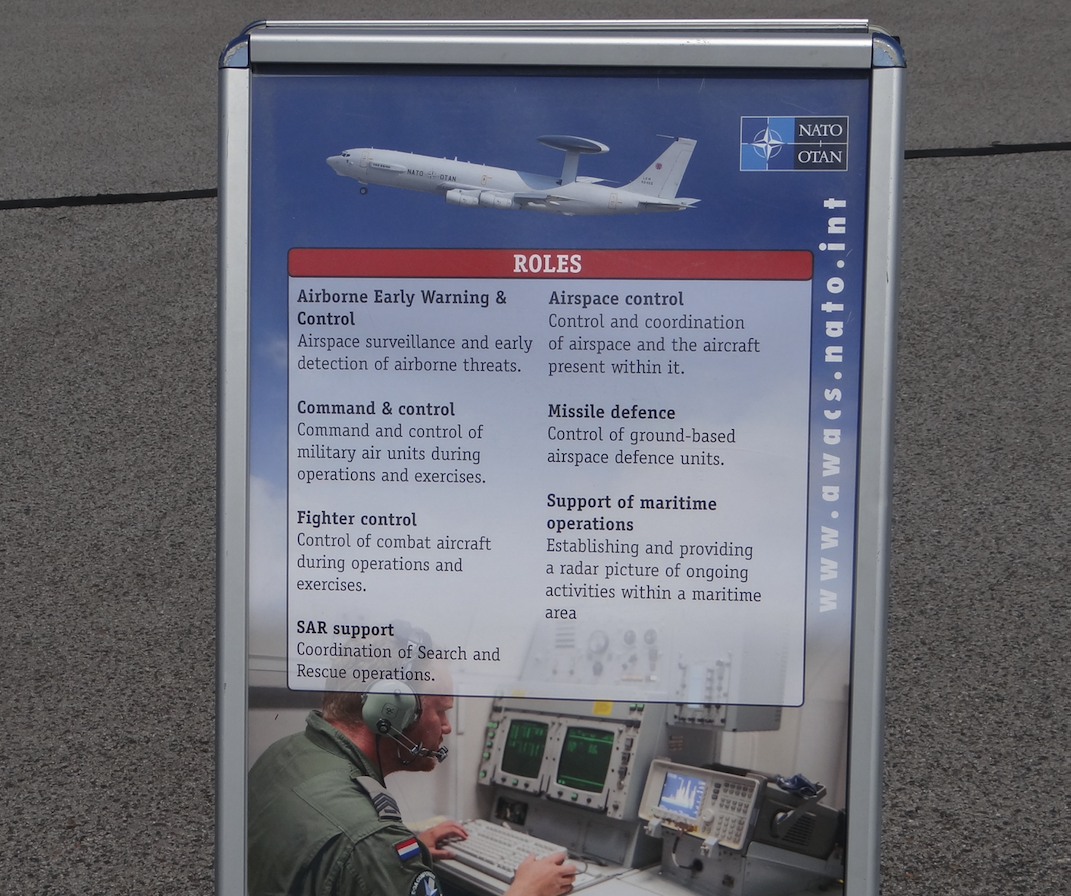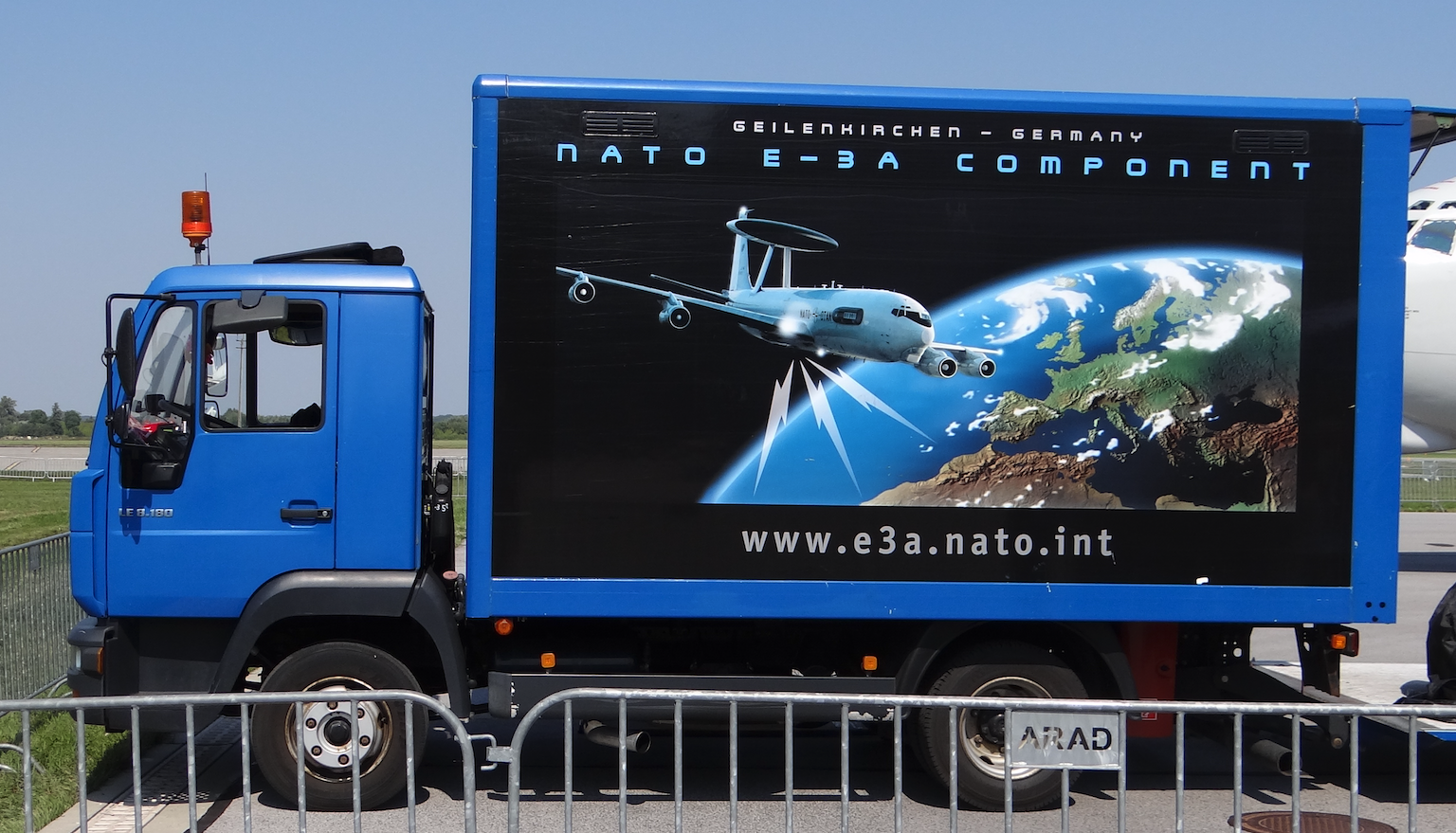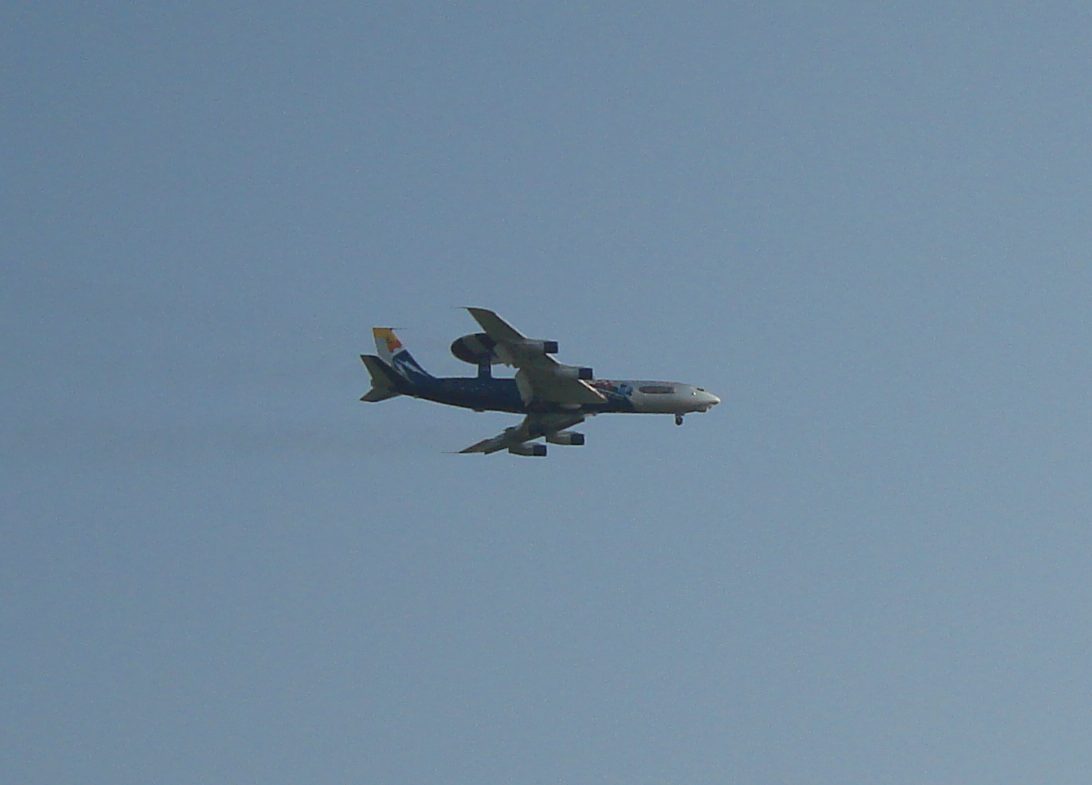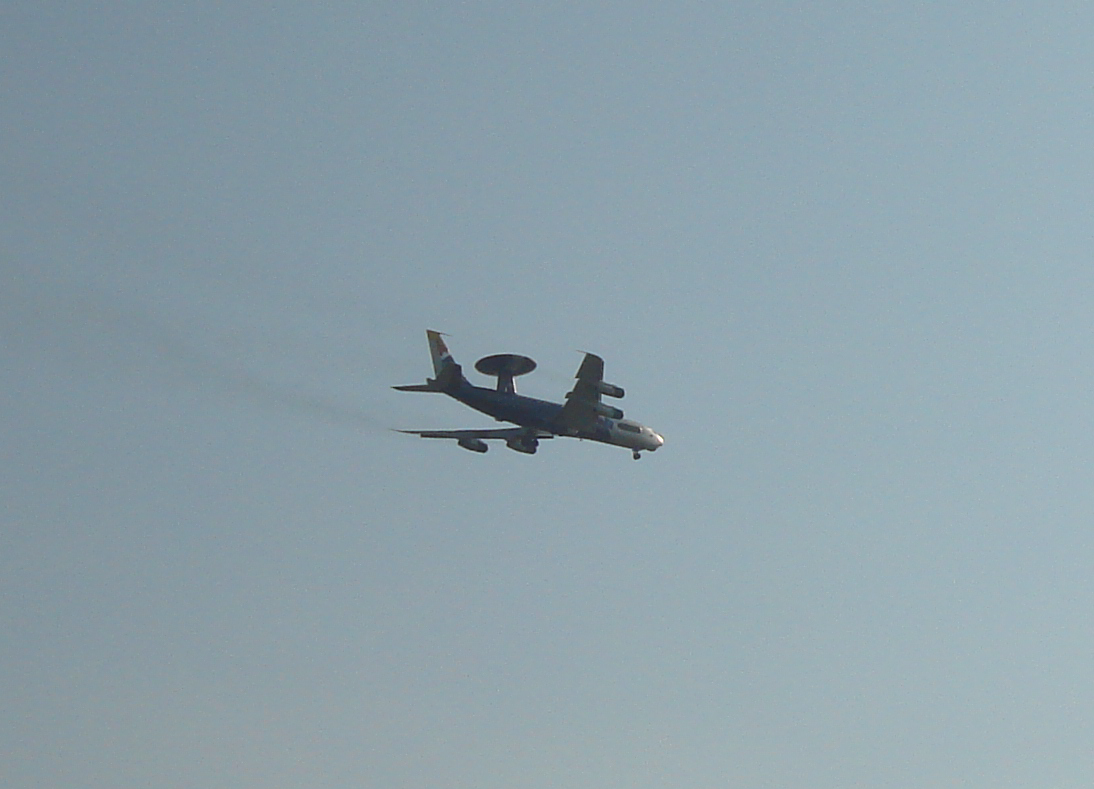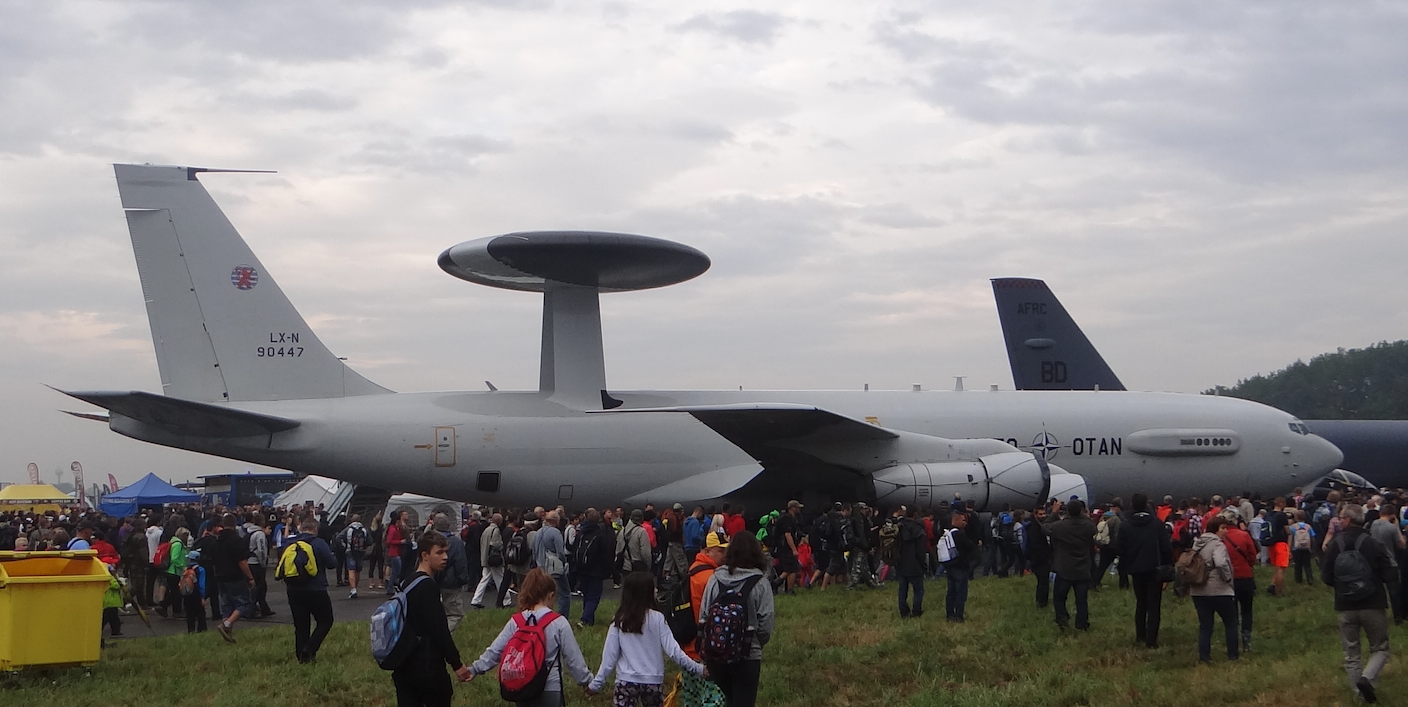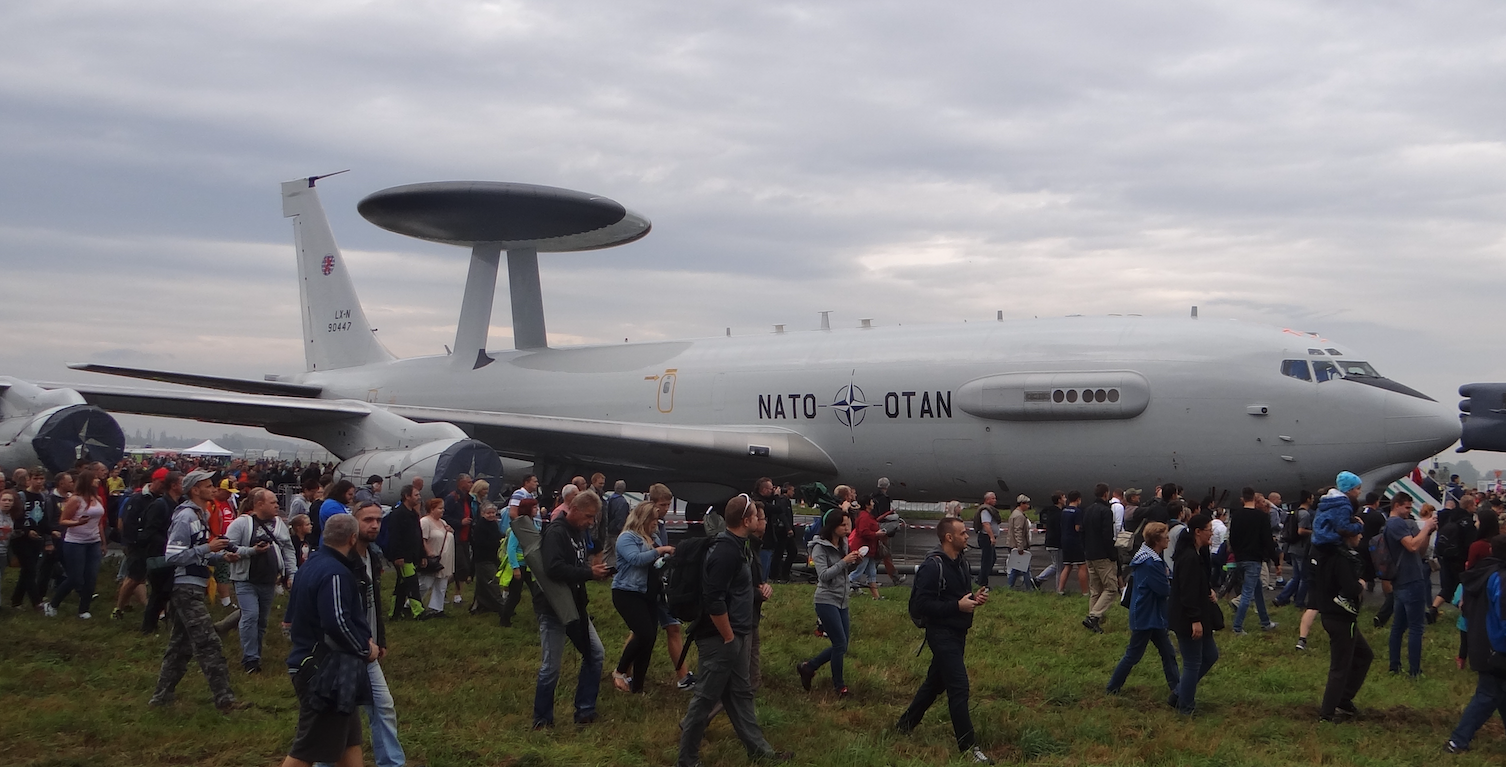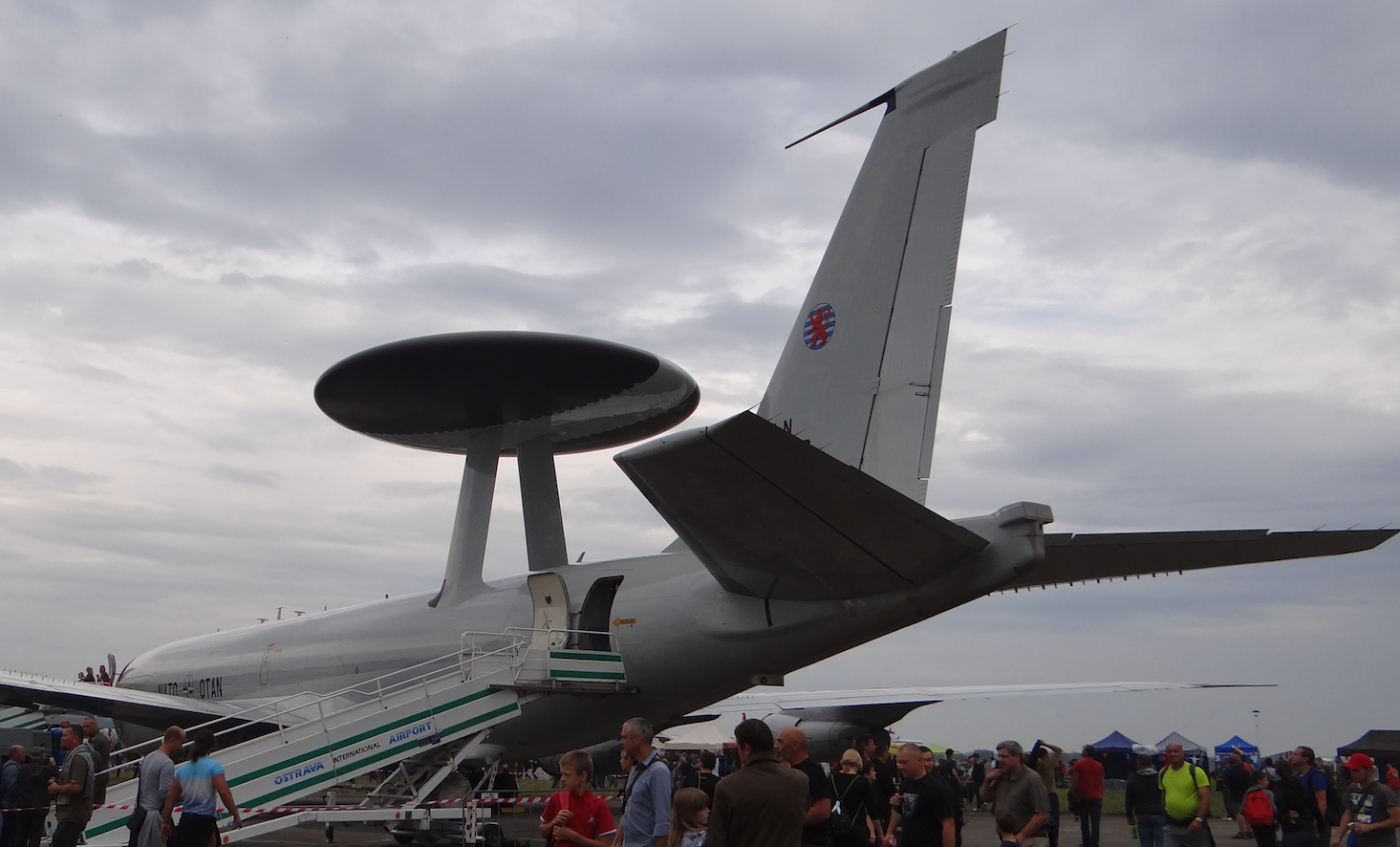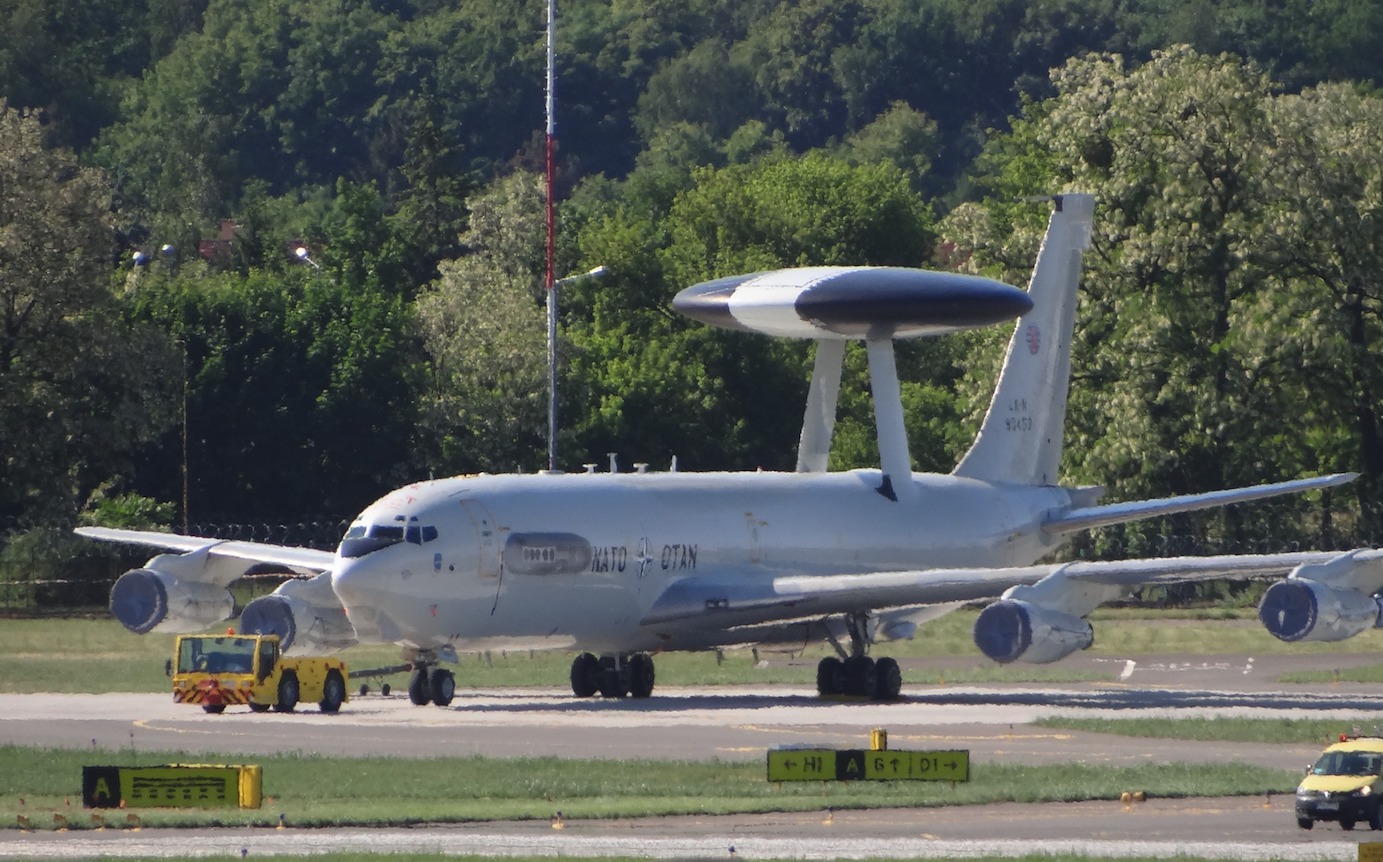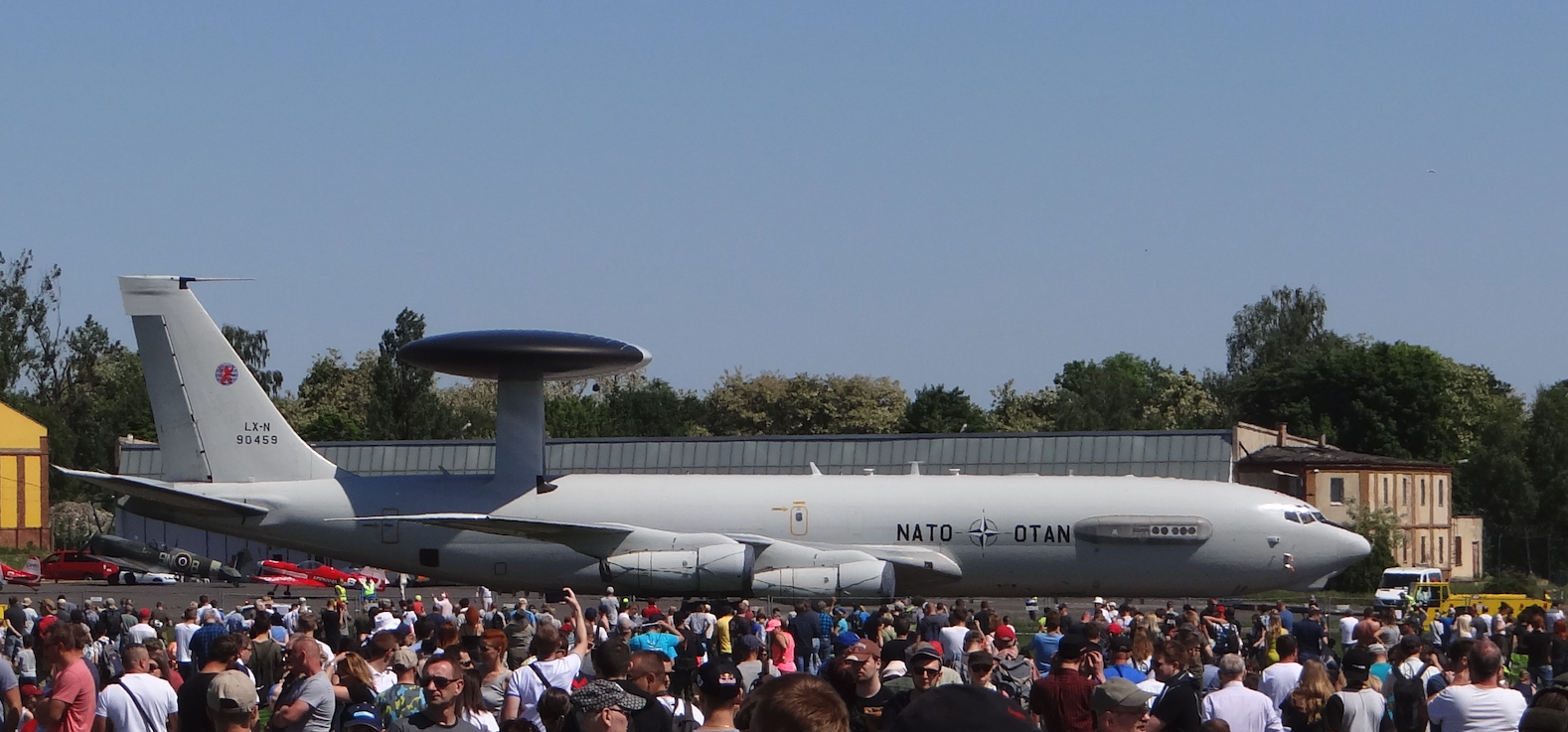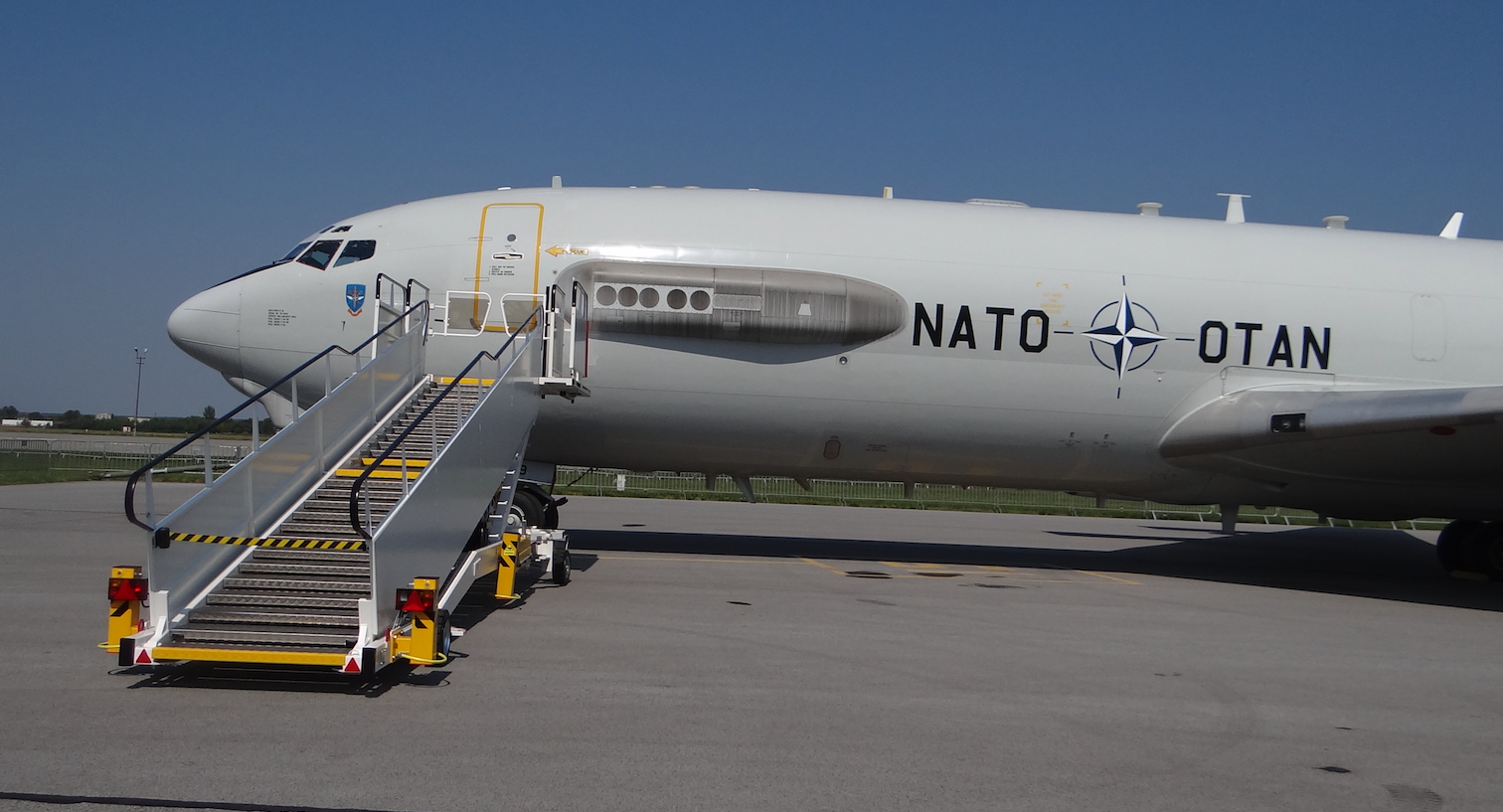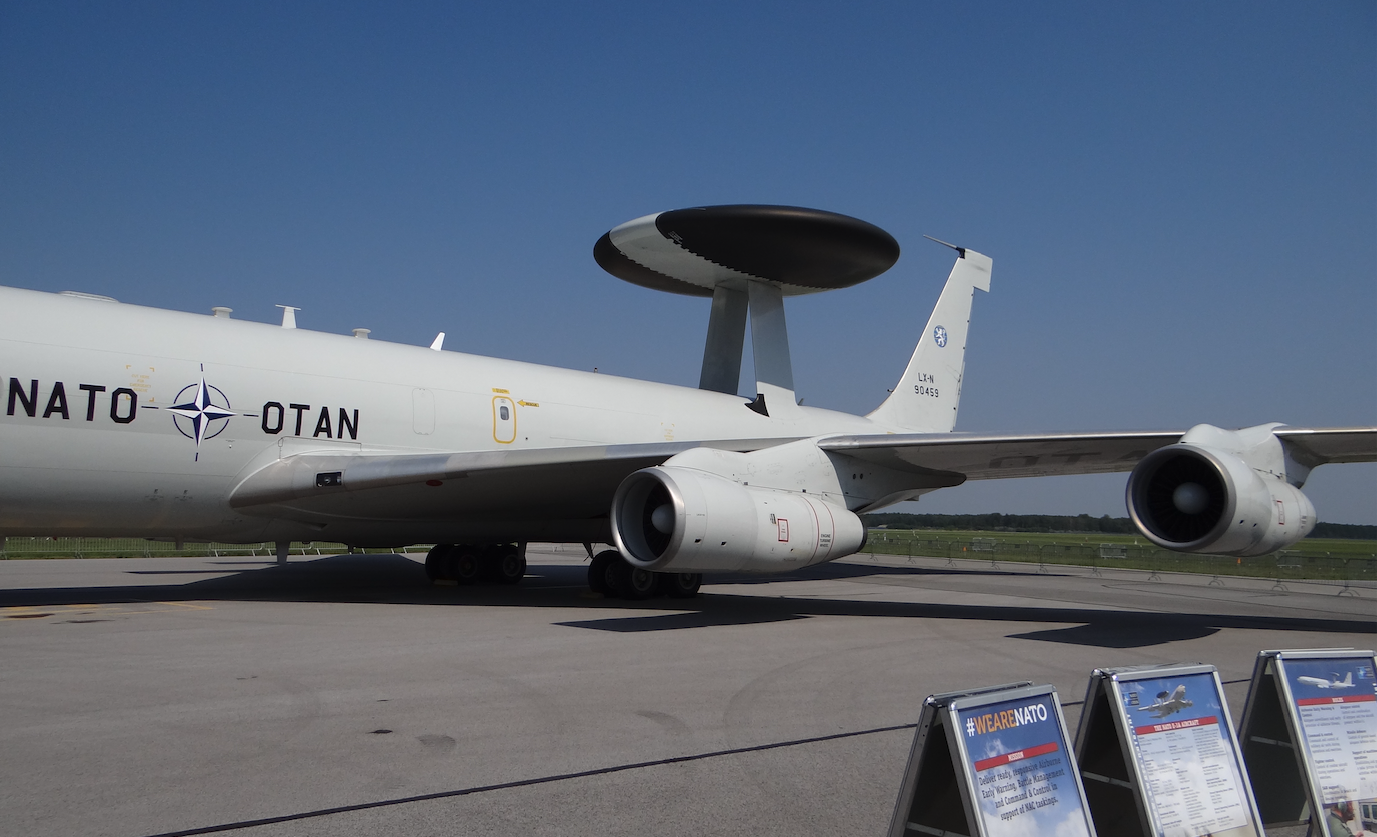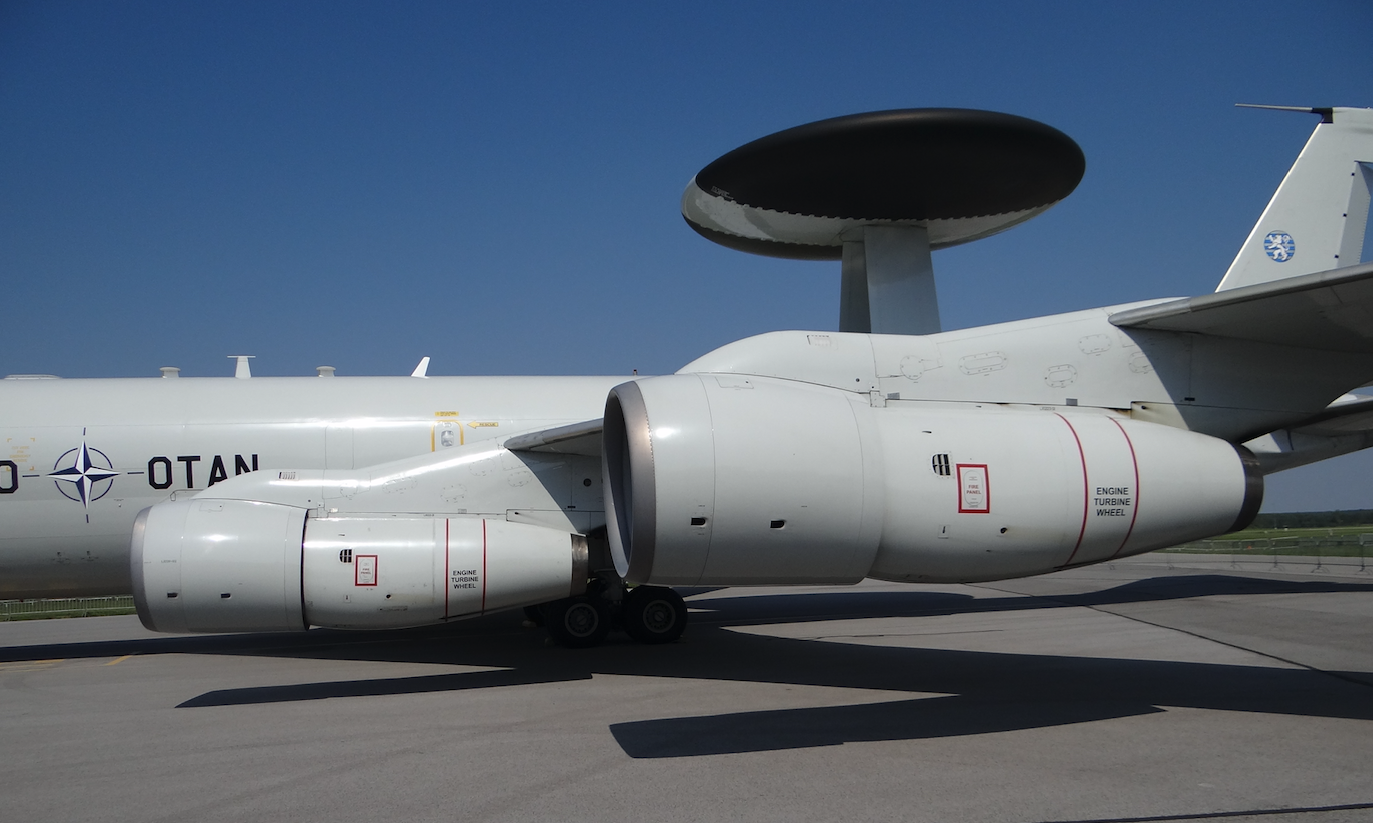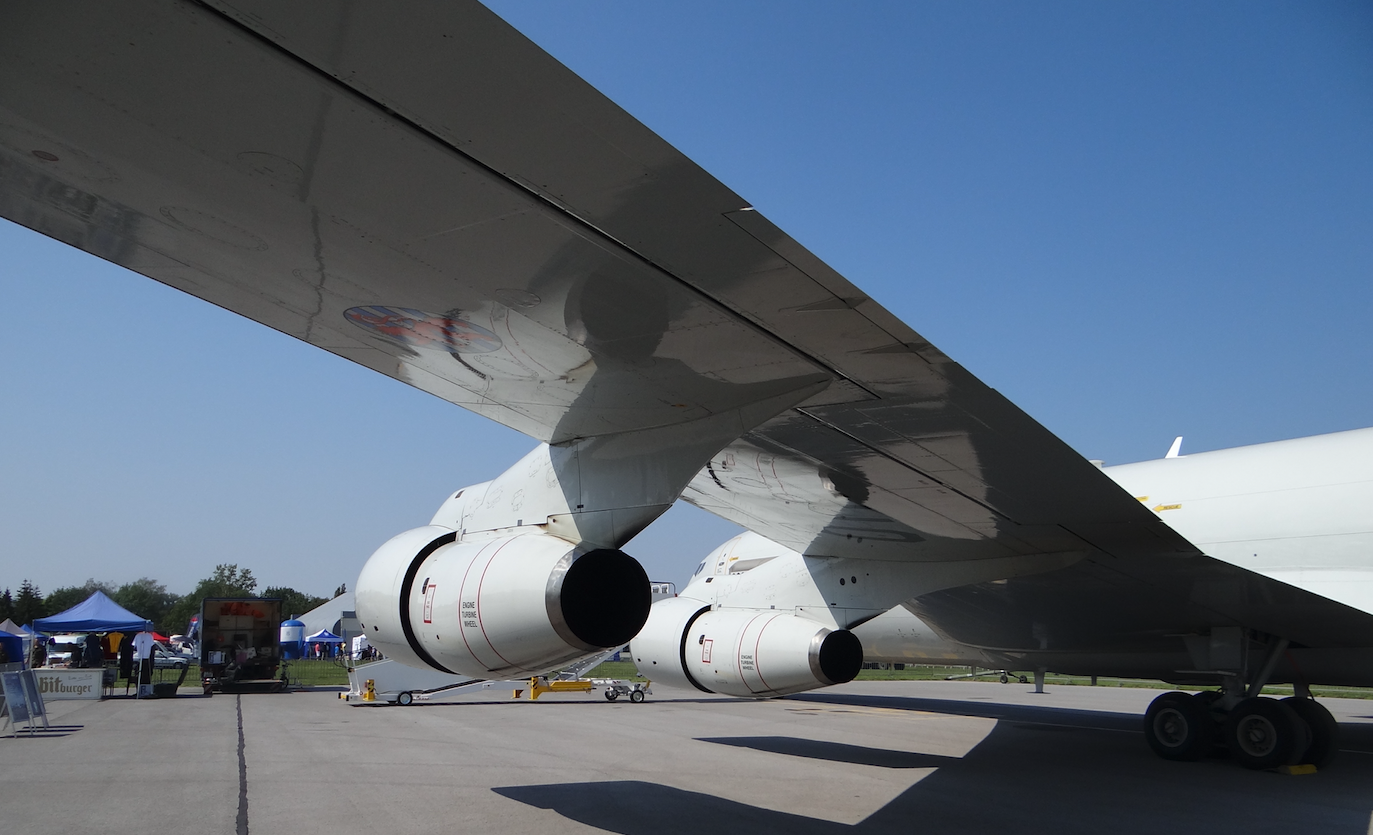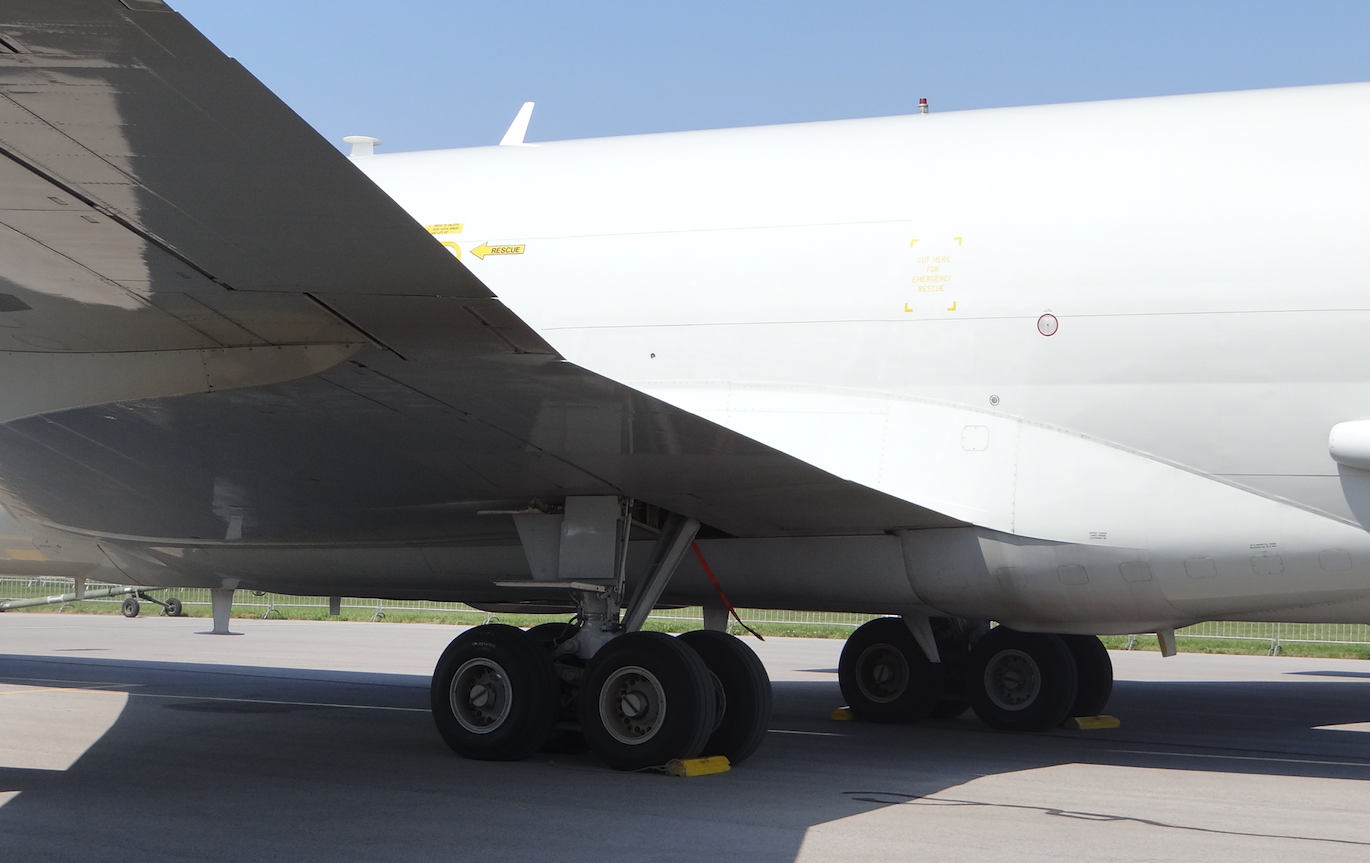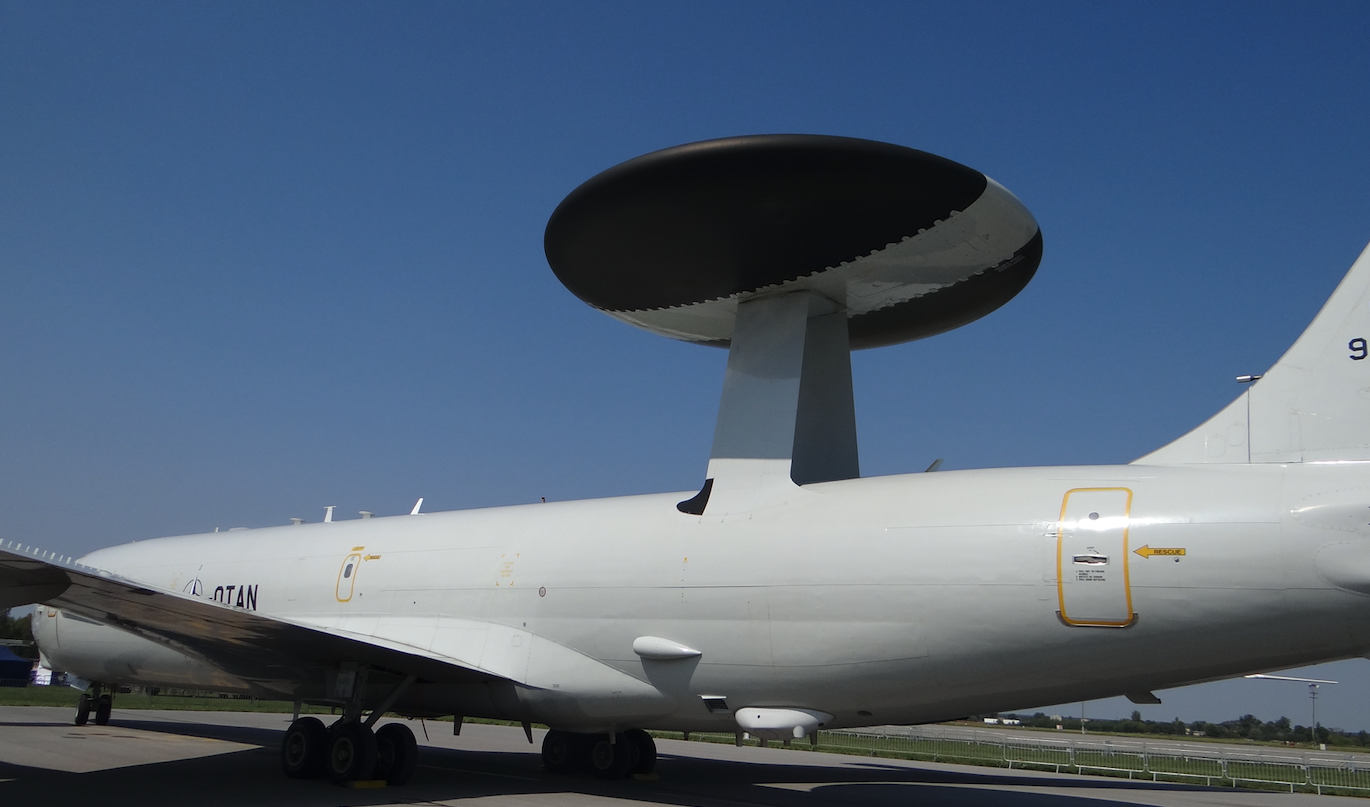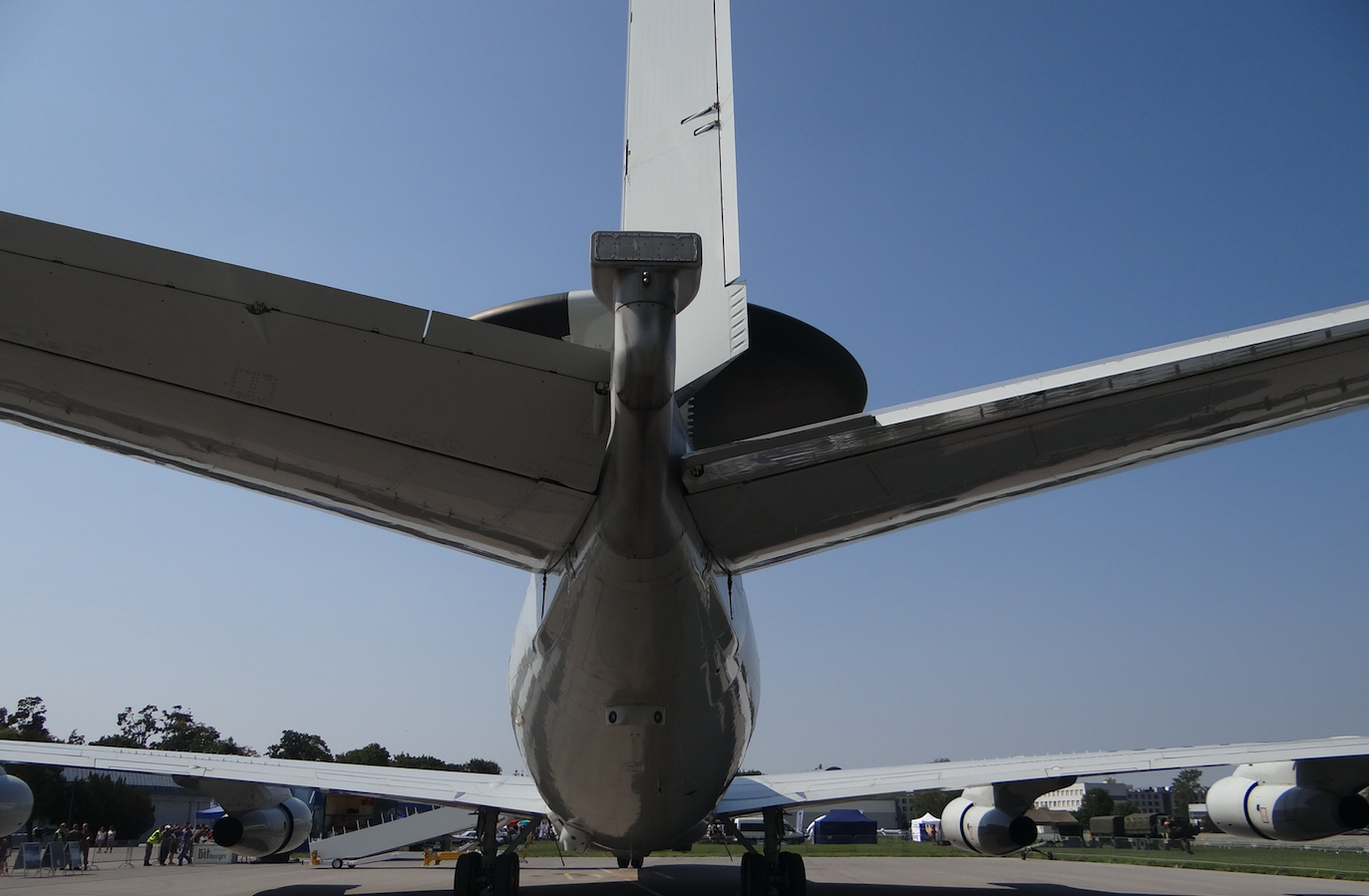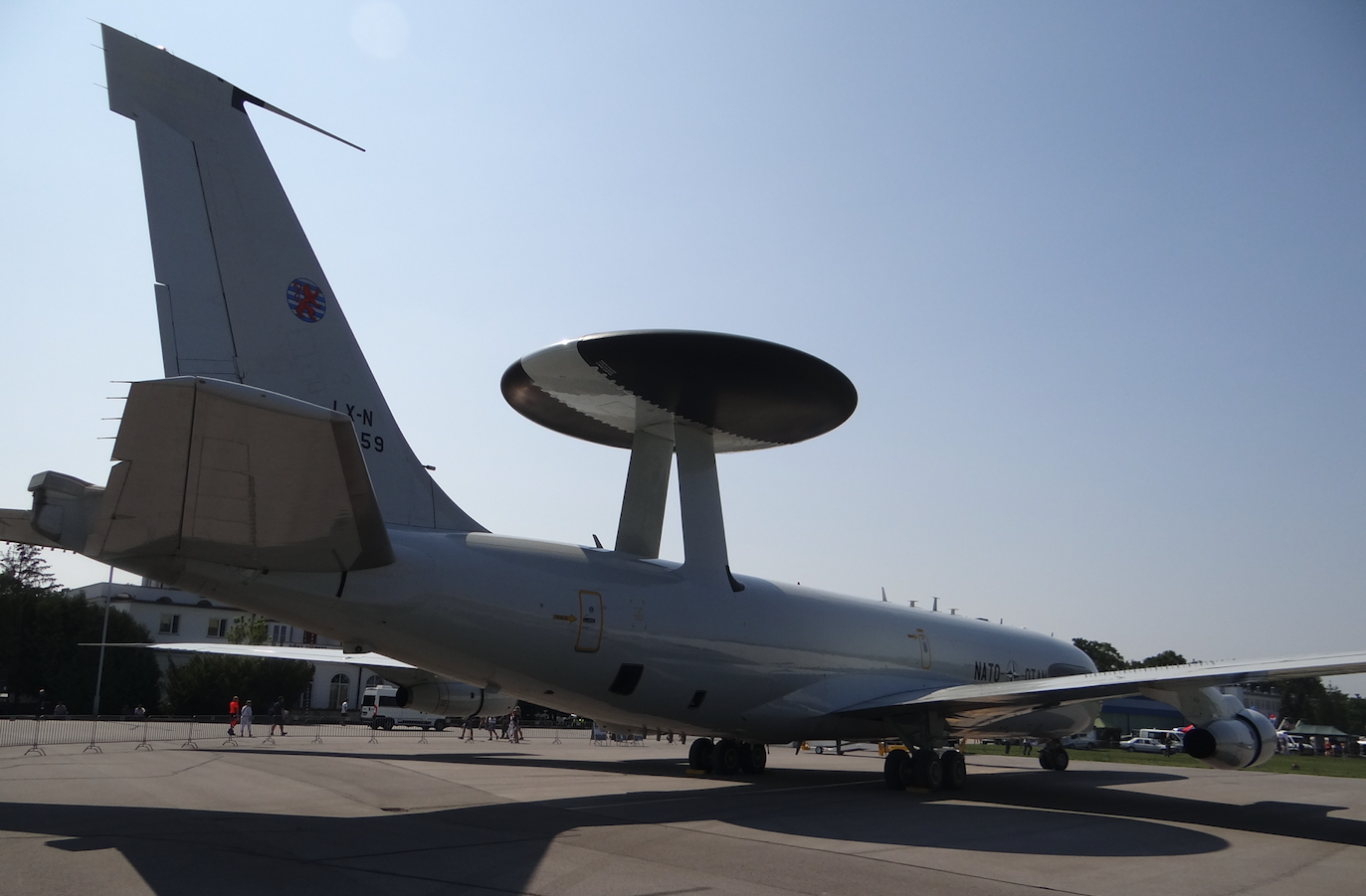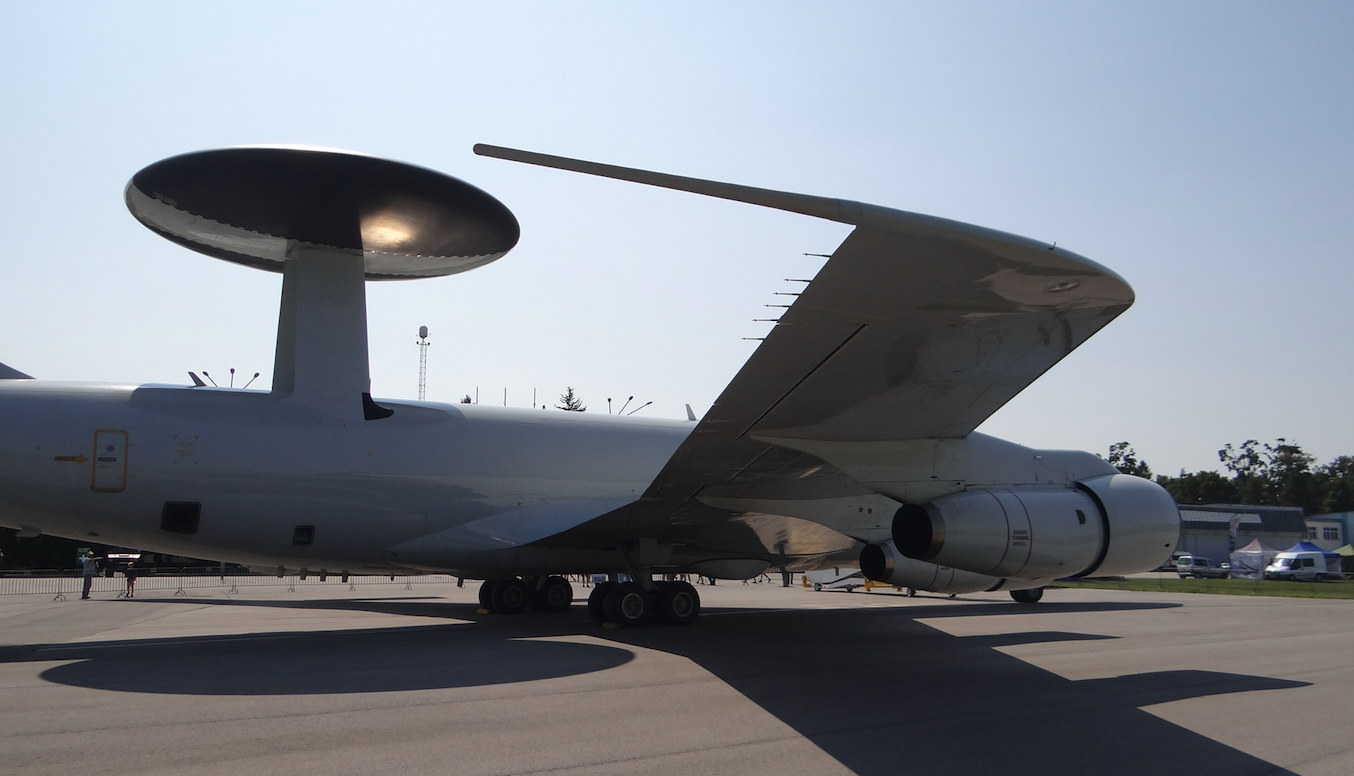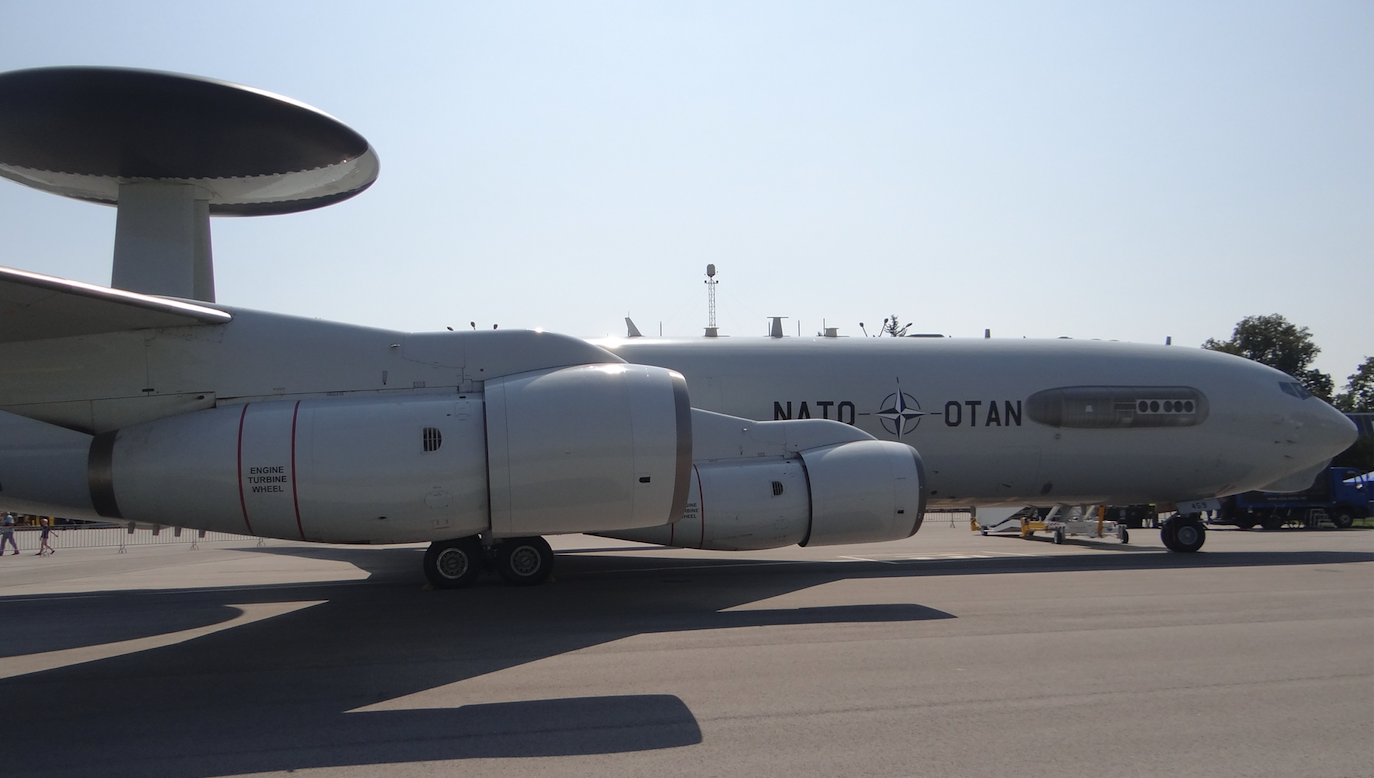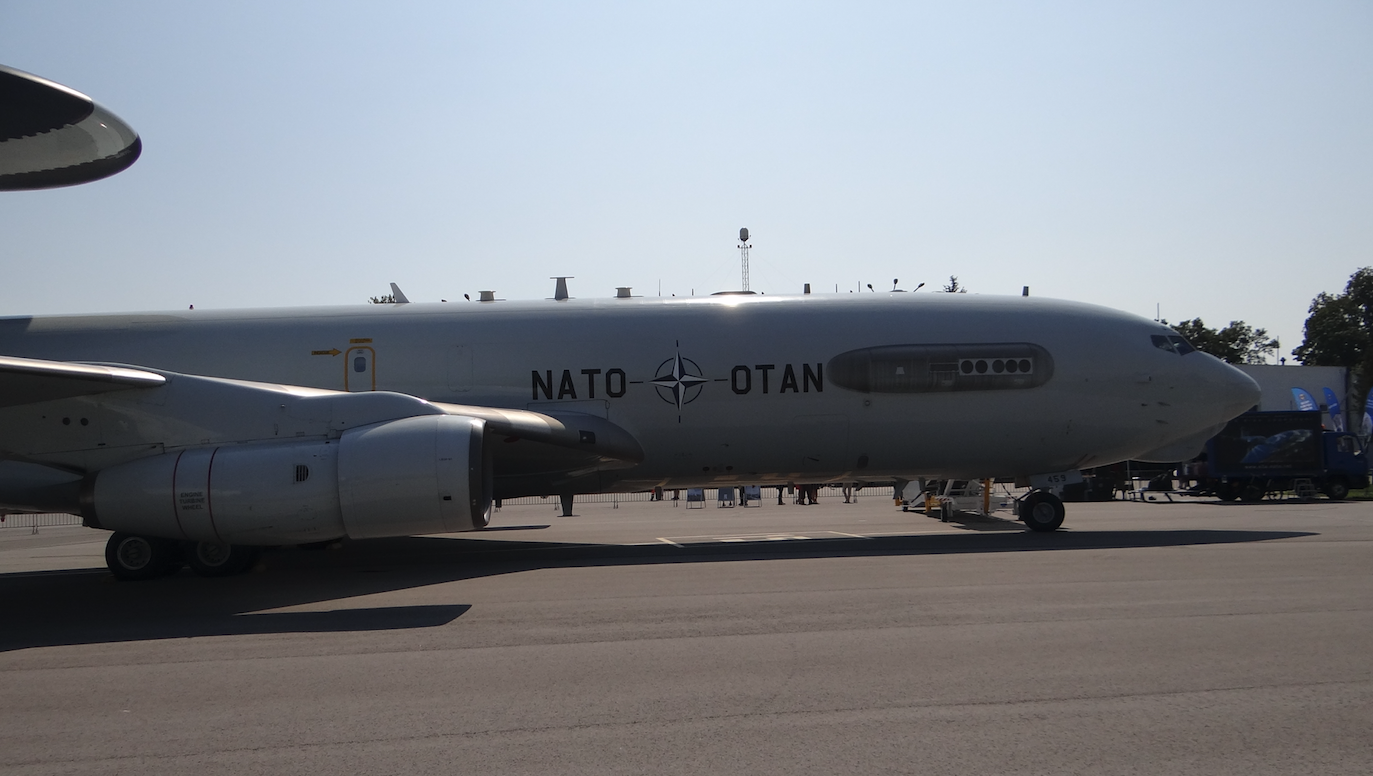Kraków 2018-09-29
292b Tally, March 12, 1999
Boeing E-3 Sentry AWACS.
Poland
History
The expression AWACS is an English acronym (abbreviation) – Airborne Warning and Control System, i.e. in Polish – Aviation System of Warning and Control. Essentially, the term AWACS refers to the Boeing E-3 Sentry early warning aircraft, which was one of the world’s first aircraft of its kind and is still the most technologically advanced to date. The predecessor of the AWACS aircraft was the EC-121 aircraft, built on the basis of the Lockheed Constellation model and used since 1955. In the USA, the Grumman E-2C Hawkeye aircraft used by the US NAVY is also popular. The latest AWACS systems are currently installed on the basis of Boeing B-767 aircraft. Japan has such planes.
Airplanes of this type have been built and are still being built by such countries as: UK, CCCP (Moscow State), China, Sweden, and Brazil. An exceptionally large number of AWACS constructions were created in CCCP, based on the following aircraft: An-12, Tu-114, Tu-20, Il-76, Il-72. However, none of them has reached a satisfactory level of use, due to the low level of development of electronics in this country.
History of the Boeing E-3A Sentry.
The demand for this type of aircraft was reported by the USAF in 1963. Work on the Boeing E-3A Sentry aircraft began in the mid-1960s. The base was the Boeing B.707-320C aircraft. Pratt & Whitney TF33-PW-100A turbofan engines with a thrust of 4 x 93 kN were selected for the drive. This engine is a military variant of the Pratt & Whitney JT3D engine. The prototype flew in 1975. The plane did not yet have complete equipment. Production lasted from 1977 to 1992. 68 examples were built. The aircraft were used by the USA (since 1977), UK, France, Saudi Arabia and NATO (since 1982).
Contrary to appearances, the Boeing E-3 Sentry aircraft was not designed for electronic warfare against the CCCP. This is because these machines can only operate in complete control of the air. For monitoring the CCCP and dependent countries, the US has established a network of ground-based radars. In turn, the aircraft is perfect for local wars, when it can effectively monitor the development of the conflict from a long distance. Therefore, after the collapse of the communist bloc, it was the only type of air force that did not undergo any reductions.
The distinguishing feature of this aircraft among others is the characteristic mushroom mounted above the aircraft’s fuselage in its rear part. The antenna of the panoramic radar station is located there. Initially, it was the AN/APY-1 version capable of tracking up to 400 air targets. The manufacturer of the radar is Northrop Grumman Electronic Sensors and Systems Sektor. The newer AN/APY-2 radar provides full coverage of high and low flying aircraft at long distances. Its adaptation to work at the sea provides observation of moving and stationary ships and ships. The radar is of the pulse-Doppler type. Although the AN/APY-1/2 radar is a design from the 1970s, after modernization it has already received digital signal input and output modules that guarantee greater detection resolution and immunity to interference. The radar looks down towards the ground, discriminating between echoes from the surface (passive interference) and from aircraft flying close to the ground to avoid detection by ground radars. At the E-3 flight altitude of 9,000 m, the range of the look-down radar to the horizon is approximately 400 km. In addition to detecting low-altitude aircraft and helicopters, it also detects surface targets up to the horizon. The total weight of the radar is over 3,700 kg. In addition to this radiolocation station, the aircraft has other sensors, friend-foreign identification devices, guidance systems, two-way encrypted communication systems (currently digital communication). The aircraft can also function as a command center.
The first version was designated EC-137 D. It entered service with the USAF in 1977. Subsequent versions are E-3 A, E-3 B, E-3 C, E-3 D (for the RAF). They have a modernized AN/APY-2 radar.
In 1982, the US decided to create a NATO unit operating in Europe, equipped with 18 Boeing E-3 A Sentry aircraft. The base was located in Germany in Geilenkirchen. Near the Dutch border, near Aachen. It is also close to Belgium. The aircraft are registered in Luxembourg and financial insurance is paid for them there. On March 12, 1999, Rzeczpospolita was admitted to NATO and became a shareholder in the NATO-AWACS component. Initially, the participation of the Polish Army was modest, but it increased over time. Due to the aggressive policy of Comrade Putin, the presence of Boeing E-3 A Sentry aircraft in Poland has become even more necessary.
One of the Boeing E-3A Sentry aircraft crashed in Greece. One of the aircraft was written off due to high wear (2015). These aircraft can be stationed in Norway, Turkey, Greece, Italy and Germany. Currently, NATO has a fleet of 16 machines of this type and it is the only military equipment belonging to the Alliance. All aircraft are stationed at Geilenkirchen Air Base in Germany. In addition, they are supported by six Royal Air Force (RAF) E-3D machines based in Waddington.
Currently (2018), their main activities are directed against the self-proclaimed Icelandic state and against comrade Putin, who is waging war in eastern Ukraine. SAR (Search and Rescue) missions have been added to the tasks for AWACS. Currently, the Boeing E-3 Sentry not only detects aircraft and determines "own-other", but also identifies them. The crew is able to obtain information about the destination of the flight of a given aircraft and whether it is in the right place. The Boeing E-3 Sentry also supports operations on land and sea: police, military, humanitarian, counter-terrorism, rescue and those related to natural disasters. During the mission over the Vistula River, they monitor the Polish airspace and air traffic beyond our eastern border. All collected information is transferred in real time to the Joint Air Operations Center in Uedem. In addition, information can be directly transferred to allied aircraft, especially combat ones, in the air.
The crew of the Boeing E-3 Sentry consists of 15-19 officers. On very difficult missions, there can be up to 30 officers on board. Those flying the NATO flag are mixed crews, composed of soldiers of the Alliance countries. The captain is responsible for the operation of the aircraft and its safety. The Chief Operations Officer – the Technical Director – is responsible for the execution of the task. These two officers work closely together. The co-pilot (copilot) is responsible for radiotelegraph communication and navigation monitoring. The captain and the co-pilot are authorized to pilot the aircraft on their own. In the cockpit, apart from the captain and the copilot, there is room for the navigator and the flight engineer. The operating room (cabin) is filled with computer stations with screens that are interfaces for reconnaissance devices installed in the aircraft. Operators who detect aerial objects work on them. This is the first group of officers. In turn, controllers responsible for establishing radio communication with the crews of other machines work at other stations. Their task is to collect as much information about air traffic as possible. This is the second group of officers. The last group of officers are technicians whose task is to ensure trouble-free operation of all systems: communication, software and radar. In theory, they remove faults, but due to the small amount of spare parts on board the aircraft, their work is limited to diagnosis and reporting. The Technical Director directly manages the work of the Surveillance Controller, who in turn is responsible for the three reconnaissance operators and the Passive Controller. The latter protects the flight of the Boeing E-3 Sentry aircraft. Generally detects enemy beacons. The second part of the team is the Weapons Team, which oversees offensive and defensive operations involving other aircraft.
By default, the Boeing E-3 Sentry aircraft operates at 30,000 feet (ft). The basic device of the Boeing E-3 Sentry is the AN/APY-2 radar. With a ceiling of 10,000 m, it covers an area of 312,000 square km. The radar is able to detect an air target with an effective reflection area of 10 square meters, flying at a low altitude from a distance of 400 km, and at an average altitude of up to 500 km. According to information from the 80s, there were two station antennas in the shield. This second antenna was intended to be placed behind the first one and is a secondary radar antenna. It is used to identify your friend and stranger.
A typical Boeing E-3 Sentry mission lasts 15-16 hours, but there have been cases of 20-hour missions in history. The time is counted from the crew boarding until the engines are turned off. Typically, the plane stays in the air for 10 hours and during this time it can cover a distance of 6,000 km. The maximum flight time is 12 hours, without refueling in the air. If there is aerial refueling, the mission can last 20 hours. Longer missions are not used because human forces are limited (concentration), and apart from fuel, oil for engines and hydraulic systems is also used, and it is not collected in the air. In addition, there are regulations that regulate the working time of military aviators.
The missions set for the Boeing E-3 Sentry aircraft depend on the tasks performed. Boeing E-3 Sentry aircraft fly over Poland relatively often. Even every two days. They mainly monitor the situation over the Baltic states. Regular flights of Boeing E-3 A Sentry aircraft over Poland began in March 2014. Since then, Boeing E-3 Sentry planes often land at Okęcie Airport in order to establish joint activities and the flight itself over Poland. Then the function of Technical Director on board the aircraft is performed by a Polish Officer. Within a month, the Boeing E-3 Sentry spends 400-450 hours in missions over Poland.
Boeing E-3 Sentry NATO and the Republic of Poland.
The Boeing E-3A Sentry aircraft has already been demonstrated many times in Rzeczpospolita. The most popular presentations took place during the Air Show Radom in 2011 and 2018 and Ławica 2018, Dęblin 2018. The plane was seen many times at the airports: Okęcie, Powidz, Ławica, Strachowice, Dęblin.
The Polish Air Force has the right to use the AWACS system in emergency or conflict situations. The aircraft helped secure the NATO summit in Poland, the World Youth Day with the participation of Pope Francis in 2016, the European Football Championship in 2012, and the visit of Pope Benedict XVI in 2006. In addition, NATO E-3A took part in many military exercises that took place in Poland. They also supported six Air Policing missions of our pilots over Lithuania, Latvia and Estonia.
In the history of the participation of Polish Soldiers in the crews of the Boeing E-3 Sentry, there were already three Polish navigators. They underwent 4-6 months of training in the Geilenkirchen base. It has been and is being used by several computer workstation operators. There were also a few Technical Directors, but this role requires missions, not direct computer desks. The highest rank among the Poles serving on board the Boeing E-3 A Sentry is Lieutenant Colonel Zygmunt Anioł.
The design of the Boeing E-3 Sentry.
The Boeing E-3 Sentry aircraft was built on the basis of the Boeing B-707-320C passenger aircraft. It is an all-metal low-wing monoplane, built in a classic layout, with swept wings and a drive consisting of four turbo-fan engines.
Wings with a leading edge angle of 35 degrees. Integral fuel tanks were placed in the wings. Krueger flaps on the leading edge, single-slotted flaps on the trailing edge. Four spoiler panels. Two sets of ailerons: low-speed external, locked when flaps are retracted, high-speed internal. Ailerons moved mechanically, with Flettner flaps. All surfaces on the wing (except ailerons) are hydraulically operated. Flaps with emergency electric drive mechanism.
Pressurized, semi-monocoque hull with ribs and stringers. It takes on board up to 30 officers. Standard cast of 15-19 people. 4 people in the cockpit: captain, co-pilot, navigator and flight mechanic.
Mechanical-hydraulic control system. Due to the "Dutch roll" phenomenon, the "Yaw Damper" damping system was used.Driven by JT3D turbofan engines. Engines equipped with thrust reversers. Starting engines with compressed air. Power generators were installed in the engine pylons.
Three-support chassis with front support, fully retractable by means of a hydraulic system. Double swivel front wheels. The main ones are four-wheeled carts. Multi-disc, hydraulic brakes.
Technical data of the Boeing E-3 Sentry:
Wingspan: 145 ft 9 in (44.42 m). Length: 152 ft 11 in (46.61 m). Height: 41 ft 4 in (12.6 m). Wing area: 3,050 sq ft (283.4 m2). Curb weight: 185,000 lb (73,480 kg). Maximum takeoff weight: 347,000 lb (157,397 kg). Top speed: 530 mph (855 km/h, 461 knots). Range: 4,000 nautical miles (7,400 km). Service ceiling: 41,000 feet (12,500 m). Powerplant: 4 × Pratt and Whitney TF33-PW-100A turbofan, 4 × 21,500 lb (4 × 93 kN).
Tally.
Since March 12, 1999, Poland as a NATO member has participated in the NATO-AWACS component. NATO currently (2018) has 16 Boeing E-3 Sentry AWACS aircraft.
Written by Karol Placha Hetman

